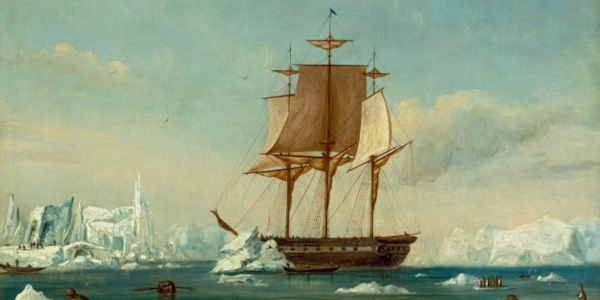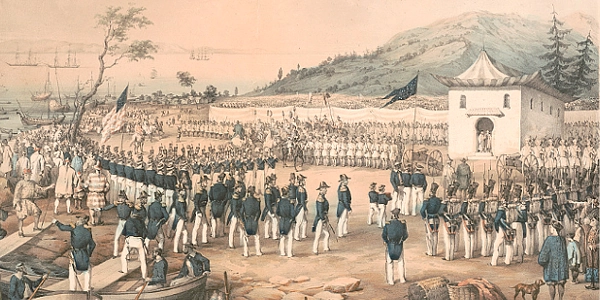Sponsor this page for $75 per year. Your banner or text ad can fill the space above.
Click here to Sponsor the page and how to reserve your ad.
-
Timeline
1826 Detail
September 3, 1826 - The first United States warship to navigate the world, the U.S.S. Vincennes, leaves New York City under the command of William Finch.

The ship was named for the Victory at Vincennes, the siege of the town Vincennes in Illinois territory (present day Indiana) during the American Revolution. The siege was conducted by militia under George Rogers Clark, including many Canadians, after he had been warned on January 29, 1779 that the British had re-occupied the fort, also known as Fort Sackville. Marching his small militia a week later, February 5, 1779, occupied by one hundred and seventy men and an armed row galley with forty men who would station themselves on the Wabash River. The main force would walk nearly two hundred miles before reaching Vincennes, and somehow had not been detected by Henry Hamilton, the British commander. Hamilton surrendered on February 25, 1779.
So when the sloop Vincennes, with eighteen guns, was commissioned on August 26, 1826, it honored a famous act, and this first ship of that name (there would be four) was given a unique mission. They were to leave the port of New York on September 3, 1826 and travel to Macao, China. The expedition would take four years. They returned to New York City after making three stops on the way back. Their return was dated June 8, 1830.
There is not much known of William Finch, the commander. He was born in England as William Bolton Finch, and joined the U.S. Navy in 1806 as a midshipman. After rising to the rank of lieutenant on January 4, 1813, he served with distinction during the War of 1812. He was given the role of Master Commandant in 1820 and commanded the first warship around the world in that capacity. After he returned with the Vincennes, he would be given the rank of captain in 1831. Now don't ask us why he and his sister changed their last name to Bolton. It was actually an Act of Congress. We have no clue. Finch (Bolton) would serve in the Navy until 1841 after stints at the Pensacola Navy Yard, and be commander of several other ships; the frigate Brandywine and the USS Jamestown. These years he was also commander of the Mediterranean Squadron and the African Squadron.
First U.S.S. Vincennes After Going Round the World
Having spent four years at sea, the original Vincennes was decommissioned two days later, only to be recommissioned, likely after refurbishment and repair, shortly after. Their next mission took them to the West Indies. It was not a fortunate journey. Yellow fever hit the crew, lasting for one year. Once home, it was decommissioned again, then recommissioned in 1833. This time their journey took them back to the Pacific Ocean, and a first visit to the island of Guam.
She would have a varied career, serving forty-one years with a variety of additional decommissions and recommissions. Perhaps its second claim for fame was even more ambitious than its first. In 1836, it was significantly remodeled to be the flagship for the Wilkes South Sea Surveying and Exploring Expedition to Antarctica. With Lieutenant Charles Wilkes at the helm of the exploration, they left Hampton Roads, Virginia in August 1838, first sailing and exploring along the South America coast. Reaching the arctic below Australia, they made a small journey to Antarctica, then sailed north to chart the Pacific Islands. Back to chart the Antarctica waters from 1839-1840, Charles Wilkes, land was first sighted on January 30, 1840. The area is known as Wilkesland, and was claimed for the United States. The Vincennes remained at sea until June 10, 1842 in New Jersey. They had now traversed the world three times. And beyond charting Artarctica, they spent time in Puget Sound, San Francisco, and Manila Bay.
However, the U.S.S. Vincennes had not completed its important work. On July 6, 1846, the sloop accompanied the Columbus under Commodore James Biddle into Edo (Tokyo Bay). The U.S. Government wanted to gain access to Japanese trade, and until that time, only the Dutch and the Chinese were allowed into one port to trade. Although this request was and would later be an ultimatum from the United States, during this voyage small ships surrounded the U.S. warships, and refused to allowed Biddle to negotiate a trade treaty. Admiral Perry would rectify that situation in 1853 by threatening to shell Tokyo.
During the final decade of the first Vincennes, they would lose thirty-six crewmembers to Gold Fever in San Francisco in 1850, cruise off the coast of South America, Puget Sound, the Ryukyu Islands in Japan, and Russia. The first U.S.S. Vincennes would be decommissioned for the last time on July 17, 1856.

The Other Three U.S.S. Vincennes
USS Vincennes #2 - CL/CA-44 New Orleans Class Cruiser. Commissioned May 21, 1936 after construction at the Bethlehem Shipbuilding Company's Fore River in Quincy, Massachusetts. It was built under the rules of the Washington Naval Treaty of 1922, thus known as a "treaty cruiser." It was later defined as a heavy cruiser due to its 8 inch guns. The Washington Naval Treaty of 1922 as well as the London Naval Treaty of 1930 were boondoggles, as both did not see the danger of Germany, Japan, and Italy becoming enemies again who would broach both treaties and eventually declare World War II with superior, outside the treaty, weapons. On September 1, 1939, with Adolf Hitler invading Poland, this Vincennes began patrolling the east coast of the United States as part of the Neutrality patrols, at times transporting gold from France and the United Kingdom to keep it from German hands. Once Japan attacked Pearl Harbor, the Vincennes participated in the Battle of the Midway, Guadalcanal, but eventually met its demise off Savo Island on August 9, 1942, when a Japanese squadron struck the ship eighty-five times.
USS Vincennes #3 - CL64 Cleveland Light Cruiser, heavier in design than the 2nd Vincennes and commissioned two years after its demise on January 21, 1944. It was six hundred and ten feet long, sixty-six feet wide, and had twelve 6" Mark 16 guns in four turrets. After its shakedown cruises to the Caribbean, the Vincennes would transit the Panama Canal and port in Pearl Harbor. It would reach Majuro in the Marshall Islands and join the Task Force 58. The fleet was under the command of Admiral Mark A. Mitscher. They headed to the Mariana Islands with the Vincennes knocking down its first target, a Mitsubishi G4 bomber on June 10, 1944. The Vincennes would see action in the campaigns of the Saipan and Pagan Islands, Iwo Jima, Guam, Okinawa, Formosa, and the Battle of the Philippine Sea. In 1945, the Vincennes #3 fought predominantly around Formosa, then Japan and Okinawa. On June 16, 1945, the Vincennes fired its final shots in the war and headed back through Pearl Harbor to Mare Island Naval Shipyard north of San Francisco for repairs. She was decommissioned from Navy service on September 10, 1946.
USS Vincennes #4 - Freedom's Fortress, CG49. The fourth generation of the Vincennes is a Guided Missile Cruiser of the Ticonderoga class. It was built at the Ingalls Shipbuilding Company in Pasgagoula, Mississippi, and commissioned on July 6, 1985. It was kept in service for nearly twenty years with its decommission on June 29, 2005. It was deployed during that time in the Pacific Ocean, Indian Ocean, and Persian Gulf. As part of the Pacific Seventh Fleet, it was the first Ticonderoga Cruiser to deploy. The 4th Vincennes was not without its controversy, as the crew mistook an Iranian civilian plane for an F-14 Tomcat, killing all 290 passengers on board. Although not an intentional act, it is still considered such by the Iran government. It would continue to be deployed on many missions, including Operation Enduring Freedom in 2001, as well as becoming the first U.S. ship to moor in Singapore, again in 2001.
Image above: USS Vincennes in Disappointment Bay during Wilkes Expedition of Antarctica, 1845/1878, Charles Wilkes. Below: Lithograph of Commodore Perry 1853 expedition landing in Japan, 1853, Hatch and Severyn, Bayard Taylor, Charles Severyn. Courtesy Library of Congress. Source Info: ussvincennes.org; Wikipedia Commons; "Africa Squadron: The U.S. Navy and the Slave Trade, 1842-1861," 2006, Andrew Carney; https://threedecks.org/; seaforces.org.






